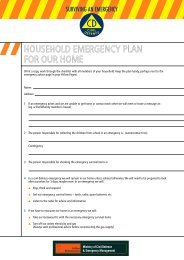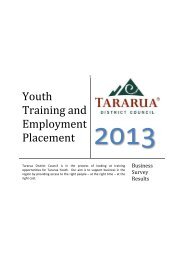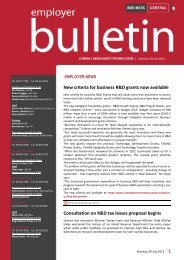Food Control Plan Checklist - Tararua District Council
Food Control Plan Checklist - Tararua District Council
Food Control Plan Checklist - Tararua District Council
- No tags were found...
Create successful ePaper yourself
Turn your PDF publications into a flip-book with our unique Google optimized e-Paper software.
The BasicsWaste management1 Goal 2 Why?To effectively manage the hygienic storage and collection ofwaste and recyclable material.Rubbish and recyclable material that is not storedappropriately and collected regularly can:• prevent effective cleaning• encourage pests• contaminate food and food handling areas.3 How this is doneWaste and recycling material is stored so that it is clearlyidentifiable and cannot be mistaken as usable.Bins and other equipment used for waste and recyclablematerial are not used for any other purpose.<strong>Food</strong> preparation areas• An adequate number of watertight waste bins are provided.• Where appropriate bins with foot-operated lid openers areused.• Bins are emptied when full and at least daily.External storage areasExternal waste bins are pest proof and easily cleaned.CleaningRubbish bins and other receptacles are cleaned regularly aspart of the cleaning schedule.Grease traps/convertersGrease traps/converters are used in accordance with themanufacturer’s instructions. Waste from grease traps iscollected every[specify when]and as needed by:Contractor:Telephone:Rubbish/Recycling CollectionWaste is collected and removed from the site every[specify when] andas needed by:Contractor:Telephone:Waste waterThe sewage and waste water system is adequate andmanaged so it doesn’t contaminate food.<strong>Food</strong> waste used for pig feedNo food waste that has come into contact with meat (cookedor uncooked)* can be used as pig feed unless it has beenheated to 100ºC for one hour. This is due to the risk ofspreading animal diseases.The person collecting the waste is responsible for meeting anyrequirements under the ‘Biosecurity (Meat and <strong>Food</strong> Waste forPigs) Regulations 2005’.Contact details of pig waste collector(s) used (if any):* this includes raw or cooked meat from any animal includingfish, poultry, snails etc.4 What if there is a problem?If rubbish/recyclable material is not being stored appropriately,check to make sure there are enough bins and that they arelocated appropriately.Review staff work habits and refresh staff training asnecessary.Resolve any problems with the waste collector as they arise. Ifproblems persist and can’t be fixed use another, more reliablewaste collector.5Write it downWrite down the cleaning instructions forbins and areas used to store waste andrecyclable material in the ‘Cleaning schedule’(see the Diary).Include the grease trap/converter in themaintenance schedule.<strong>Food</strong> <strong>Control</strong> <strong>Plan</strong> Version 3.0 2011 B11







